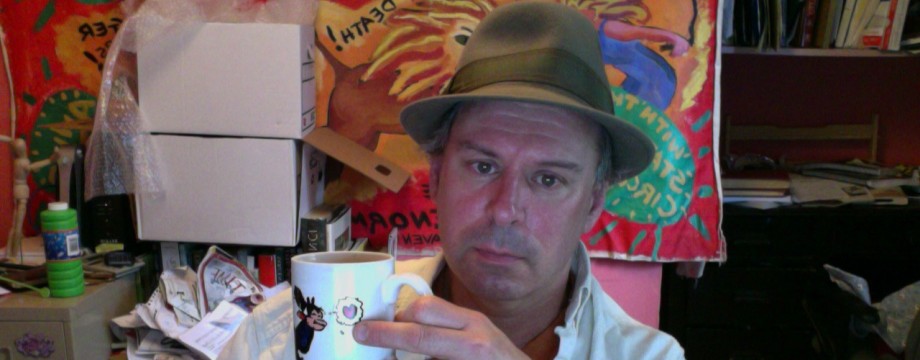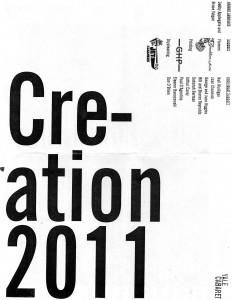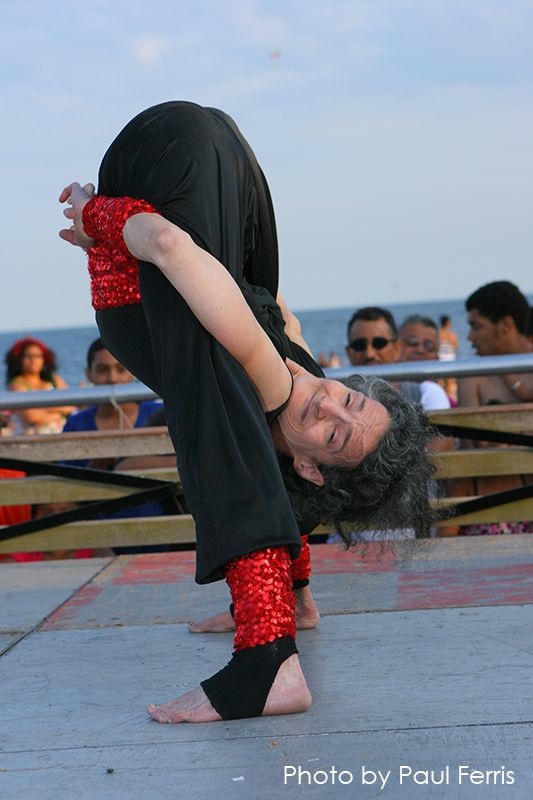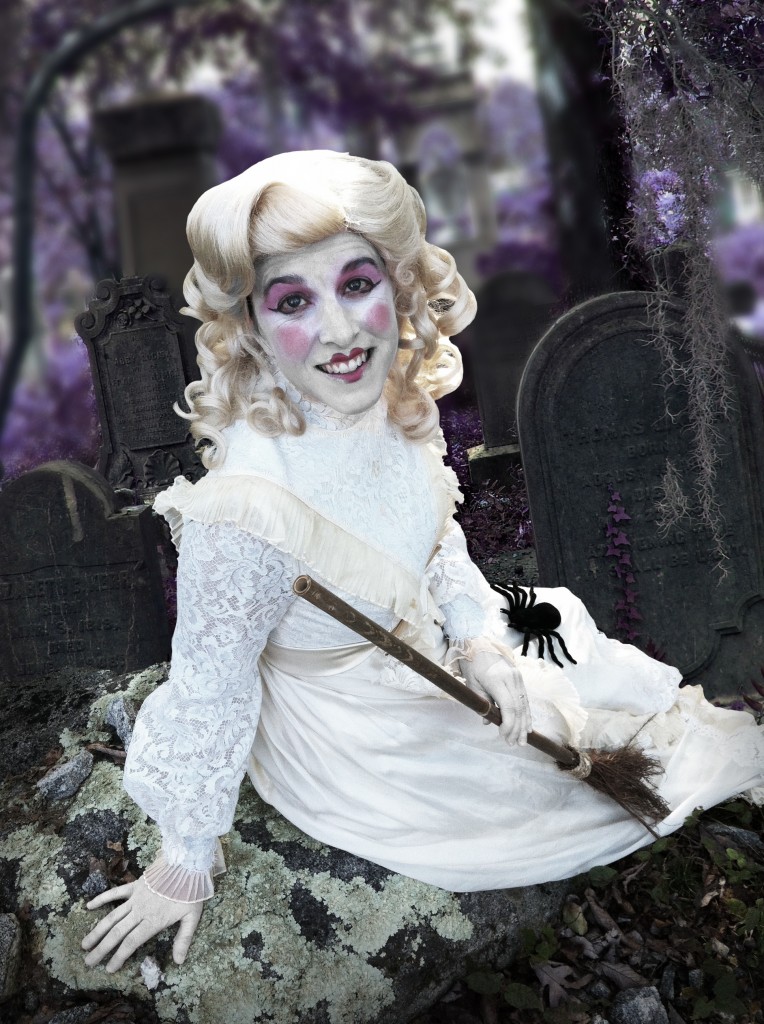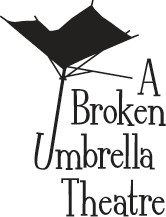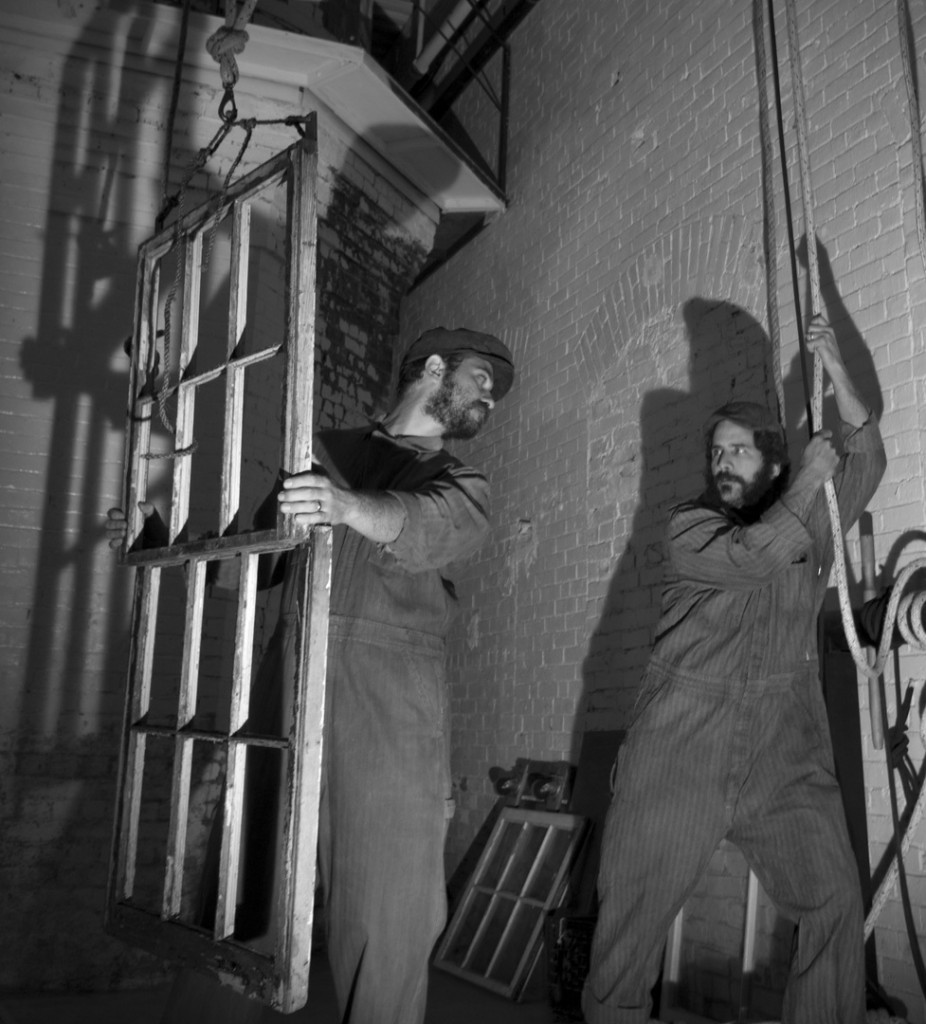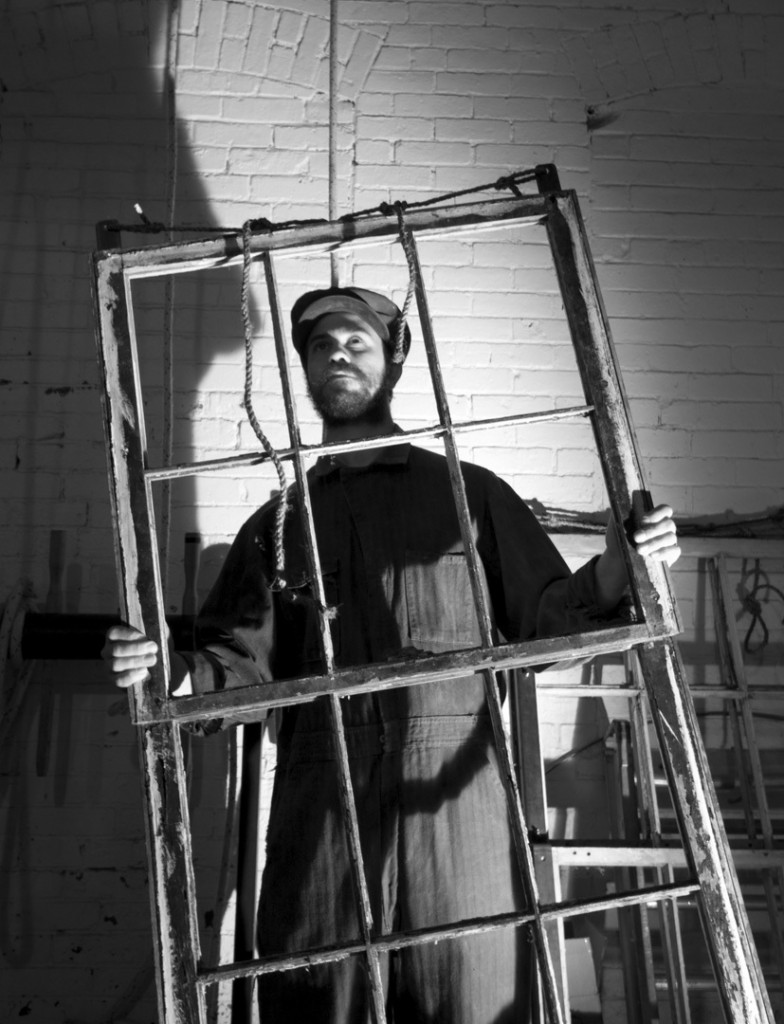
Metaphors and symbolisms abound in Play With Matches, but don't worry—that's not the scary part. Photo by Dana Astmann.
Play With Matches
Through Nov. 6 at 446A Blake St. in the Westville section of New Haven. Conceived and created by A Broken Umbrella Theatre. Directed by Ian Alderman. Written by Jason Patrick Wells. Set Design/properties: Jen McClure. Set Design: Brandon Fuller. Lighting Design: Jason Patrick Wells. Costume Design: Jacy Barber. Composer/pianist: Dana Astmann. Sound Design/Composer: Dave Baker. Projection Design: Nadir Balan. Production Manager: Ryan Gardner. Production Stage Manager: Charlie Alexander. Production Assistant Stage Manager: Grace O’Brien. Assistant Stage Manager: Luis Ayala. Historian: Colin Caplan. Producers: Ian Alderman, Rachel Alderman, Ryan Gardner, Jes Mack.
You really feel in good hands with A Broken Umbrella Theatre.
Not safe hands, mind you. In Play With Matches, hands glow in the dark. Hands steal, and point menacingly, and pound angrily on doors with evil intent. It’s a Halloween show, torn from local newspaper headlines of the 1880s, 1930s and 1960s. A key figure is Ebenezer Beecher, a quirky old coot who played with matches to the extent that he produced Diamond Safety Matches at a factory right here in town.
I found every aspect of this show unexpectedly impressive, raising the standards for what small local theater companies can accomplish. When you hear that a troupe is staging something in a deserted factory building, of course you expect musty, dusty rooms and dirt-covered floors. But this space is part of a clean, renovated building already occupied by a couple of non-profit businesses. There was plenty of cleaning up to do, the Broken Umbrella folks attest, but they went for a scrubbed, spotless look rather than earthy. They erected scaffolding, catwalks and a sound booth. There are more lighting units than I could count, plus a professional projection machine. The set is a pitch-perfect mix not just of all the eras represented in the play, but of the script’s haunting mash-up of traditional drama and Theater of the Absurd.
Even the scene before you enter the space is a well-designed enticement. In lieu of a lobby, the box office table and extensive exhibits touting A Broken Umbrella, the Westville arts scene in general and the historical background of the play are arranged in tented areas in the parking lot outside the theater entrance.
Play With Matches
Through Nov. 6 at 446A Blake St. in the Westville section of New Haven. Conceived and created by A Broken Umbrella Theatre. Directed by Ian Alderman. Written by Jason Patrick Wells. Set Design/properties: Jen McClure. Set Design: Brandon Fuller. Lighting Design: Jason Patrick Wells. Costume Design: Jacy Barber. Composer/pianist: Dana Astmann. Sound Design/Composer: Dave Baker. Projection Design: Nadir Balan. Production Manager: Ryan Gardner. Production Stage Manager: Charlie Alexander. Production Assistant Stage Manager: Grace O’Brien. Assistant Stage Manager: Luis Ayala. Historian: Colin Caplan. Producers: Ian Alderman, Rachel Alderman, Ryan Gardner, Jes Mack.
You really feel in good hands with A Broken Umbrella Theatre.
Not safe hands, mind you. In Play With Matches, hands glow in the dark. Hands steal, and point menacingly, and pound angrily on doors with evil intent. It’s a Halloween show, torn from local newspaper headlines of the 1880s, 1930s and 1960s. A key figure is Ebenezer Beecher, a quirky old coot who played with matches to the extent that he produced Diamond Safety Matches at a factory right here in town.
I found every aspect of this show unexpectedly impressive, raising the standards for what small local theater companies can accomplish. When you hear that a troupe is staging something in a deserted factory building, of course you expect musty, dusty rooms and dirt-covered floors. But this space is part of a clean, renovated building already occupied by a couple of non-profit businesses. There was plenty of cleaning up to do, the Broken Umbrella folks attest, but they went for a scrubbed, spotless look rather than earthy. They erected scaffolding, catwalks and a sound booth. There are more lighting units than I could count, plus a professional projection machine. The set is a pitch-perfect mix not just of all the eras represented in the play, but of the script’s haunting mash-up of traditional drama and Theater of the Absurd.
Even the scene before you enter the space is a well-designed enticement. In lieu of a lobby, the box office table and extensive exhibits touting A Broken Umbrella, the Westville arts scene in general and the historical background of the play are arranged in tented areas in the parking lot outside the theater entrance.
How well do they use this space? Well, it’s got a huge garage door, and they slam it. It’s got a wall that circles around the old factory chimney, and they use that usually shaping to good advantage. The story concerns hidden documents, and the set is loaded with trap doors, secret passages and other structural surprises. When the action flashes forward from the turn of the 20th century to the 1960s, it’s represented by a freakin’ Volkswagen being driven onstage.
Such a sturdily built and evocative atmosphere allows you to drift comfortably into the play and concentrate on the plot. It does require some careful attention—the changing moods and the conversations which drift across different decades can get hard to piece together. But it’s much more engrossing than a more traditional, linear ghost story would be. Playwright Jason Patrick Wells embodies these characters—many of them pulled from New Haven history books—with grand ambitions that they profess in inspiring monologues. As disappointments mount and darkness descends, the mood changes from idealistic to disenchanted, and then to just plain enchanted. Play With Matches ends up being about much more than the stubborn and graceless match-manufacturer Ebenezer Beecher. It’s about inspiration and collaboration and the creative process. It’s about lighting sparks which ignite flames throughout generations. It’s about hope at times of destruction and confusion.
This frenetic and fanciful work also happily has a light side, with a comical corps of construction workers lugging a gigantic boulder shaped like a dog. Other comic relief is provided by a hippie (Lou Mangini). Some of the mystery shenanigans resemble the denouement of an episode of Scooby-Doo.
The variety of styles at work makes the acting unavoidably uneven, but it’s still astounding how much Play With Matches aspires to do in its brisk 90 minutes, and how much of that it accomplishes. Ebenezer Beecher’s character is fully fleshed out (until he becomes a ghost that is; Ryan Gardner gives him an air of exasperation that makes him both funny and scary), but so is that of his daughter Helena (Jes Mack, modulating a role which lesser talents might turn into aimless fretting and shrieking) and his brother L. Wheeler Beecher. This spat-happy family is intruded upon by a future generation of idealists, a road-tripping duo from Ohio named Buddy and Brandt. They too are given human as well as humorous qualities; as Brandt, Ruben Ortiz treads a fine line between straight man (to Lou Mangini goofy flower child Buddy) and transformed, bright-eyed innovator.
Not that there isn’t a clichéd curly-mustached villain or two. This is still the A Broken Umbrella troupe which unleashed Vaudevillain last Halloween and delights as much in theatrical artifice as is modernism and realism.
Don’t want to tip their hand any more—there are scares and surprise aplenty. Greatest thrill for me was seeing such a new company clicking on all cylinders. Play With Matches scores with solid preparation, elegant presentation, awesome amibience, ambitious scripting and audacious acting. Best of all, this is a community-minded endeavor through and through. These are Westville’s own ghosts, scared up by of New Haven’s most enterprising theater companies.
Lift your lighters high in their honor.
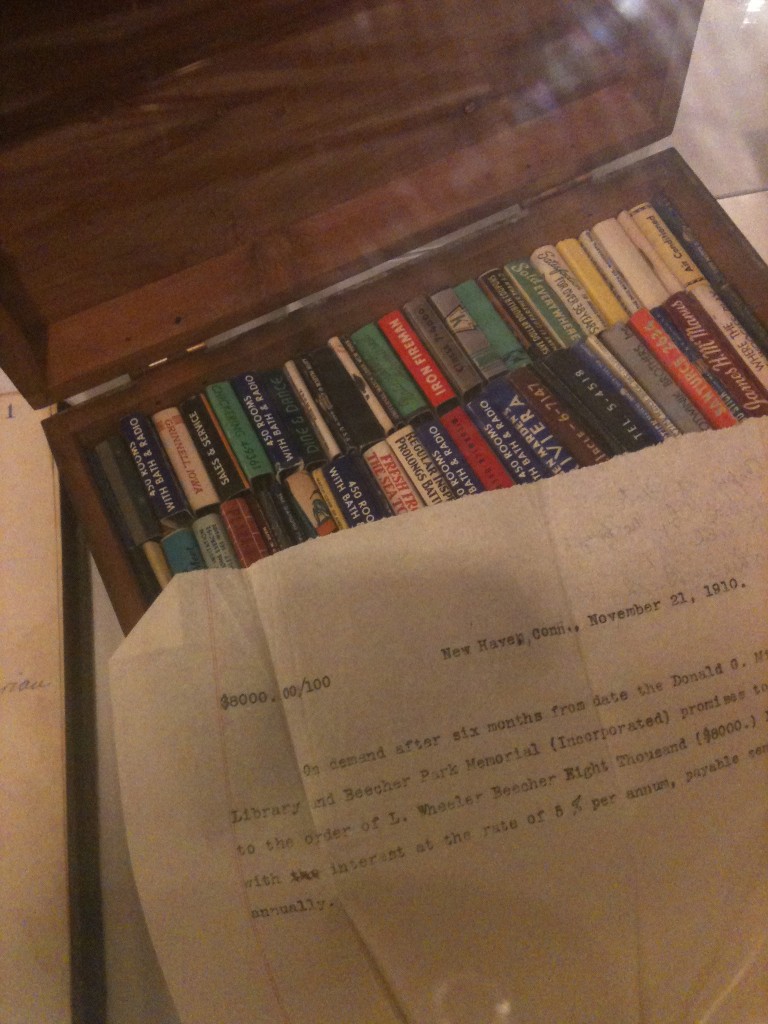
A glass case outside the theater, containing historical documents and matchbooks relevant to the goings-on in the play. Photo by Christopher Arnott.
How well do they use this space? Well, it’s got a huge garage door, and they slam it. It’s got a wall that circles around the old factory chimney, and they use that usually shaping to good advantage. The story concerns hidden documents, and the set is loaded with trap doors, secret passages and other structural surprises. When the action flashes forward from the turn of the 20th century to the 1960s, it’s represented by a freakin’ Volkswagen being driven onstage.
Such a sturdily built and evocative atmosphere allows you to drift comfortably into the play and concentrate on the plot. It does require some careful attention—the changing moods and the conversations which drift across different decades can get hard to piece together. But it’s much more engrossing than a more traditional, linear ghost story would be. Playwright Jason Patrick Wells embodies these characters—many of them pulled from New Haven history books—with grand ambitions that they profess in inspiring monologues. As disappointments mount and darkness descends, the mood changes from idealistic to disenchanted, and then to just plain enchanted. Play With Matches ends up being about much more than the stubborn and graceless match-manufacturer Ebenezer Beecher. It’s about inspiration and collaboration and the creative process. It’s about lighting sparks which ignite flames throughout generations. It’s about hope at times of destruction and confusion.
This frenetic and fanciful work also happily has a light side, with a comical corps of construction workers lugging a gigantic boulder shaped like a dog. Other comic relief is provided by a hippie (Lou Mangini). Some of the mystery shenanigans resemble the denouement of an episode of Scooby-Doo.
The variety of styles at work makes the acting unavoidably uneven, but it’s still astounding how much Play With Matches aspires to do in its brisk 90 minutes, and how much of that it accomplishes. Ebenezer Beecher’s character is fully fleshed out (until he becomes a ghost that is; Ryan Gardner gives him an air of exasperation that makes him both funny and scary), but so is that of his daughter Helena (Jes Mack, modulating a role which lesser talents might turn into aimless fretting and shrieking) and his brother L. Wheeler Beecher. This spat-happy family is intruded upon by a future generation of idealists, a road-tripping duo from Ohio named Buddy and Brandt. They too are given human as well as humorous qualities; as Brandt, Ruben Ortiz treads a fine line between straight man (to Lou Mangini goofy flower child Buddy) and transformed, bright-eyed innovator.
Not that there isn’t a clichéd curly-mustached villain or two. This is still the A Broken Umbrella troupe which unleashed Vaudevillain last Halloween and delights as much in theatrical artifice as is modernism and realism.
Don’t want to tip their hand any more—there are scares and surprise aplenty. Greatest thrill for me was seeing such a new company clicking on all cylinders. Play With Matches scores with solid preparation, elegant presentation, awesome amibience, ambitious scripting and audacious acting. Best of all, this is a community-minded endeavor through and through. These are Westville’s own ghosts, scared up by of New Haven’s most enterprising theater companies.
Lift your lighters high for Play With Matches.

